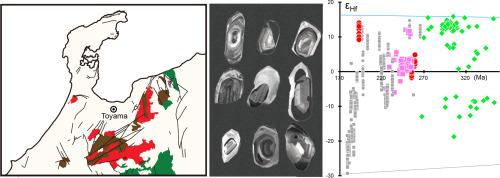Geoscience Frontiers ( IF 8.9 ) Pub Date : 2021-01-23 , DOI: 10.1016/j.gsf.2021.101145 Deung-Lyong Cho , Tae-Ho Lee , Yutaka Takahashi , Takenori Kato , Keewook Yi , Shinae Lee , Albert Chang-sik Cheong

|
Zircon U–Pb and Hf isotope data integrated in this study for magmatic and metamorphic rocks from the Hida Belt, southwest Japan, lead to a new understanding of the evolution of the Cordilleran arc system along the ancestral margins of present-day Northeast Asia. Ion microprobe data for magmatic zircon domains from eight mafic to intermediate orthogneisses in the Tateyama and Tsunogawa areas yielded weighted mean 206Pb/238U ages spanning the entire Permian period (302–254 Ma). Under cathodoluminescence, primary magmatic growth zones in the zircon crystals were observed to be partially or completely replaced by inward-penetrating, irregularly curved featureless or weakly zoned secondary domains that mostly yielded U–Pb ages of 250–240 Ma and relatively high Th/U ratios (> 0.2). These secondary domains are considered to have been formed by solid-state recrystallization during thermal overprints associated with intrusions of Hida granitoids. Available whole-rock geochemical and Sr–Nd isotope data as well as zircon age spectra corroborate that the Hida Belt comprises the Paleozoic–Mesozoic Cordilleran arc system built upon the margin of the North China Craton, together with the Yeongnam Massif in southern Korea. The arc magmatism along this system was commenced in the Carboniferous and culminated in the Permian–Triassic transition period. Highly positive εHf(t) values (> +12) of late Carboniferous to early Permian detrital zircons in the Hida paragneisses indicate that there was significant input from the depleted asthenospheric mantle and/or its crustal derivatives in the early stage of arc magmatism. On the other hand, near-chondritic εHf(t) values (+5 to −2) of magmatic zircons from late Permian Hida orthogneisses suggest a lithospheric mantle origin. Hf isotopic differences between magmatic zircon cores and the secondary rims observed in some orthogneiss samples clearly indicate that the zircons were chemically open to fluids or melts during thermal overprints. Resumed highly positive zircon εHf(t) values (>+9) shared by Early Jurassic granitoids in the Hida Belt and Yeongnam Massif may reflect reworking of the Paleozoic arc crust.
中文翻译:

日本西南部飞ida带岩浆和变质岩的锆石U–Pb年代学和Hf同位素地球化学
这项研究中整合的锆石U–Pb和Hf同位素数据用于日本西南部飞ida带的岩浆和变质岩,使人们对如今的东北亚祖先边缘的山脉弧系统演化有了新的认识。立山和津浓川地区从8个镁铁质岩体到中间正片麻岩岩浆锆石域的离子微探针数据得出的加权平均值为206 Pb / 238整个二叠纪(302-254 Ma)的年龄。在阴极发光下,观察到锆石晶体的主要岩浆生长区被向内穿透,不规则弯曲的无特征或弱带化的次级畴部分或完全替代,这些畴主要产生250–240 Ma的U–Pb年龄和相对较高的Th / U比率(> 0.2)。这些次级区域被认为是由于与飞ida类花岗岩侵入有关的热叠印期间的固态重结晶而形成的。现有的全岩地球化学和Sr-Nd同位素数据以及锆石年龄光谱证实,飞ida地带包括建在华北克拉通边缘的古生代—中生代山脉山脉弧系,以及韩国南部的Yeongnam地块。沿该系统的弧岩浆作用始于石炭纪,并在二叠纪-三叠纪过渡期达到顶峰。高度肯定ε的Hf(吨石炭晚的)值(> 12),以在飞弹副片麻岩早二叠碎屑锆石表明有从耗尽软流圈地幔和/或弧岩浆的早期阶段其地壳衍生物显著输入。在另一方面,近球粒ε铪(吨从晚二叠飞弹片麻岩岩浆锆的)的值(5至-2)提供一个地幔原点。在一些正交生岩样品中观察到的岩浆锆石核与次生轮缘之间的同位素差异清楚地表明,锆石在热套印过程中化学上对流体或熔体开放。续高度阳性锆ε的Hf(吨)飞ida地带和岭南地块的侏罗纪早期花岗岩类共有的值(> +9)可能反映了古生代地壳的重新构造。


























 京公网安备 11010802027423号
京公网安备 11010802027423号